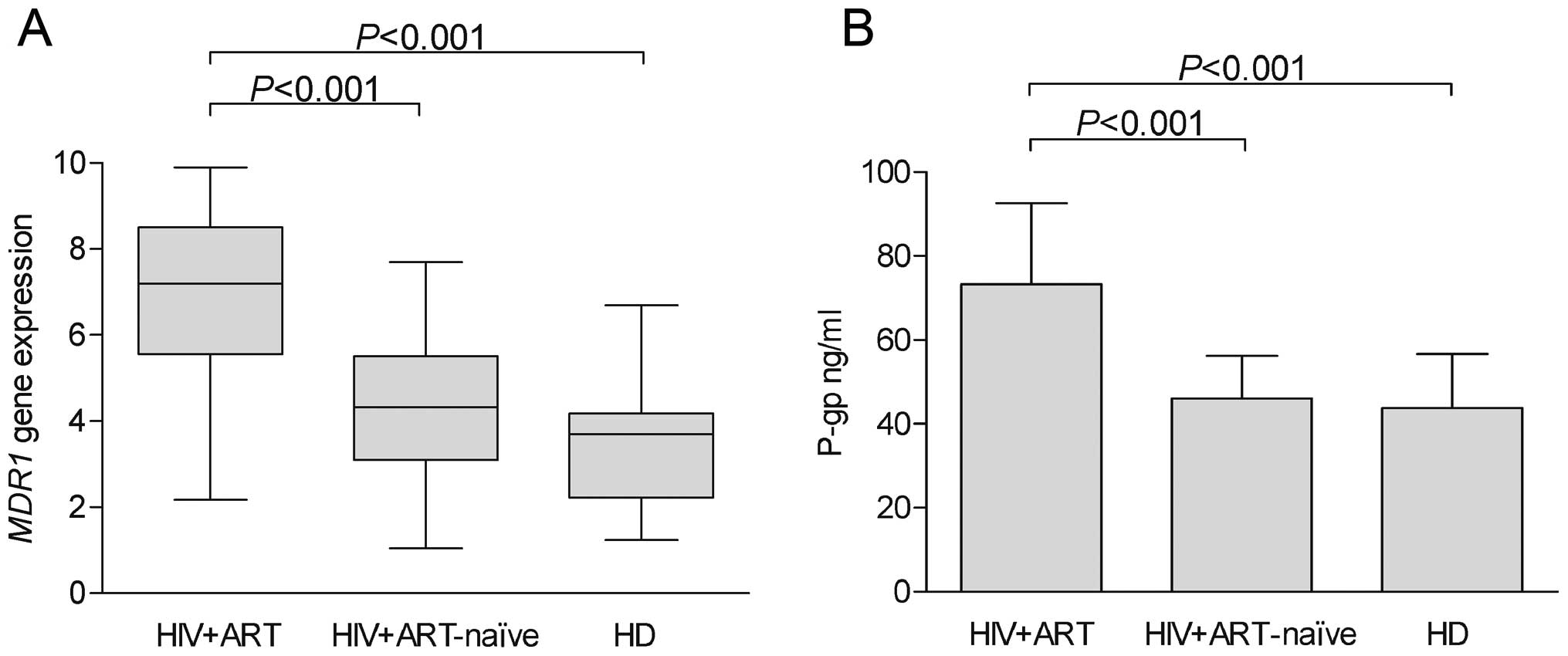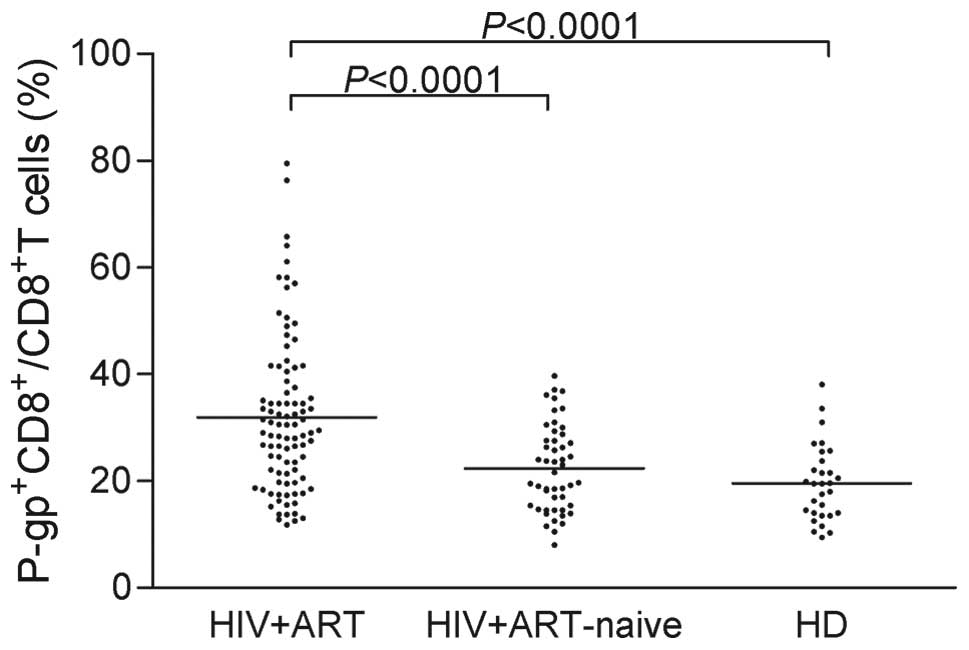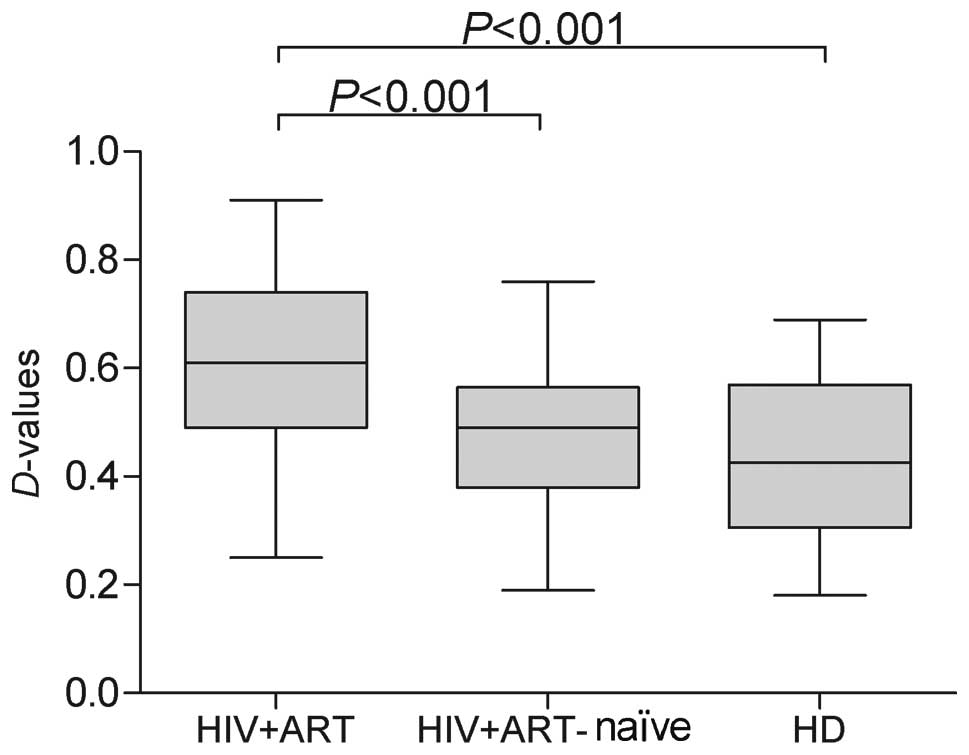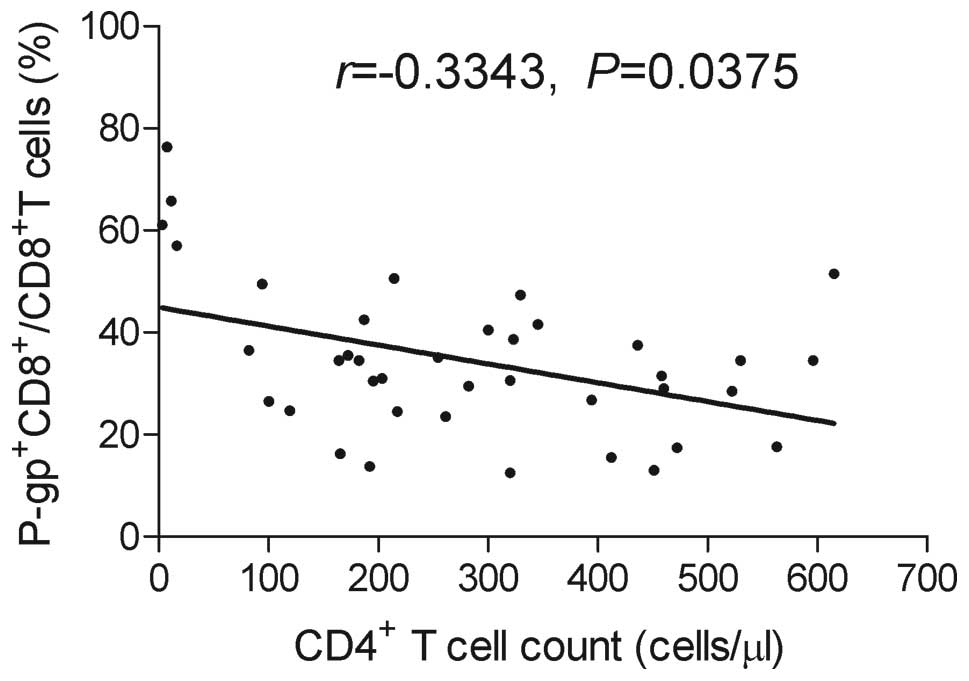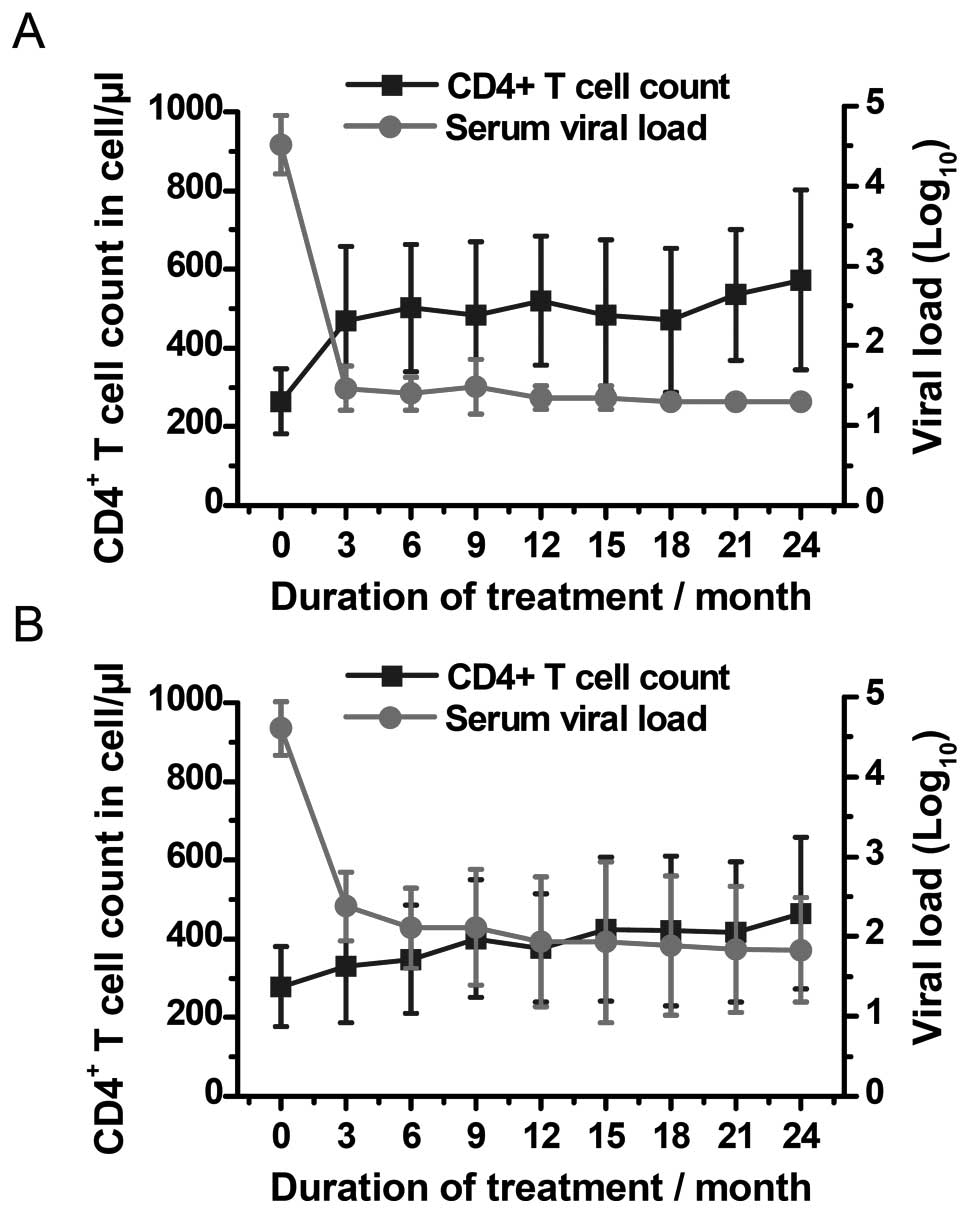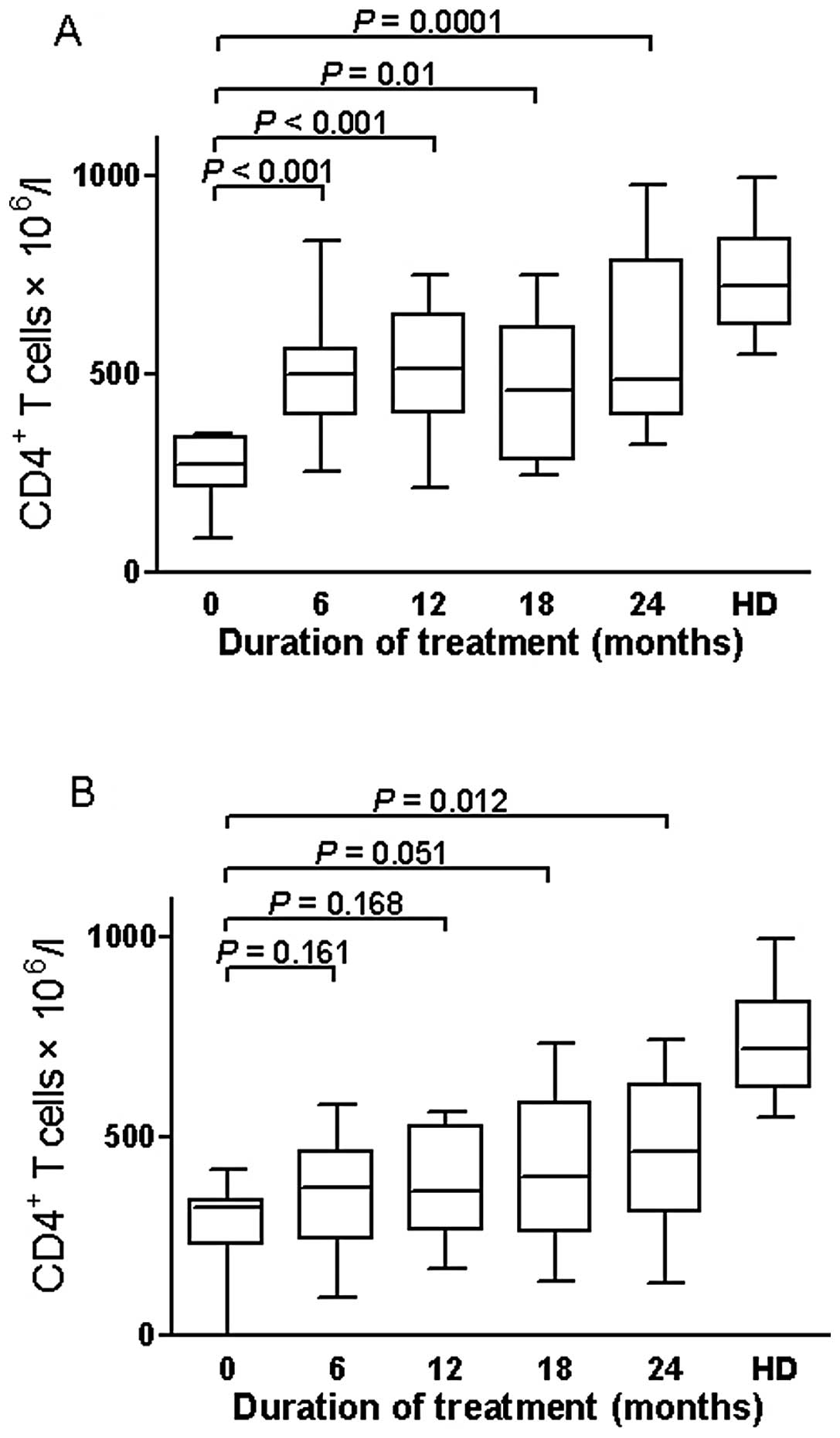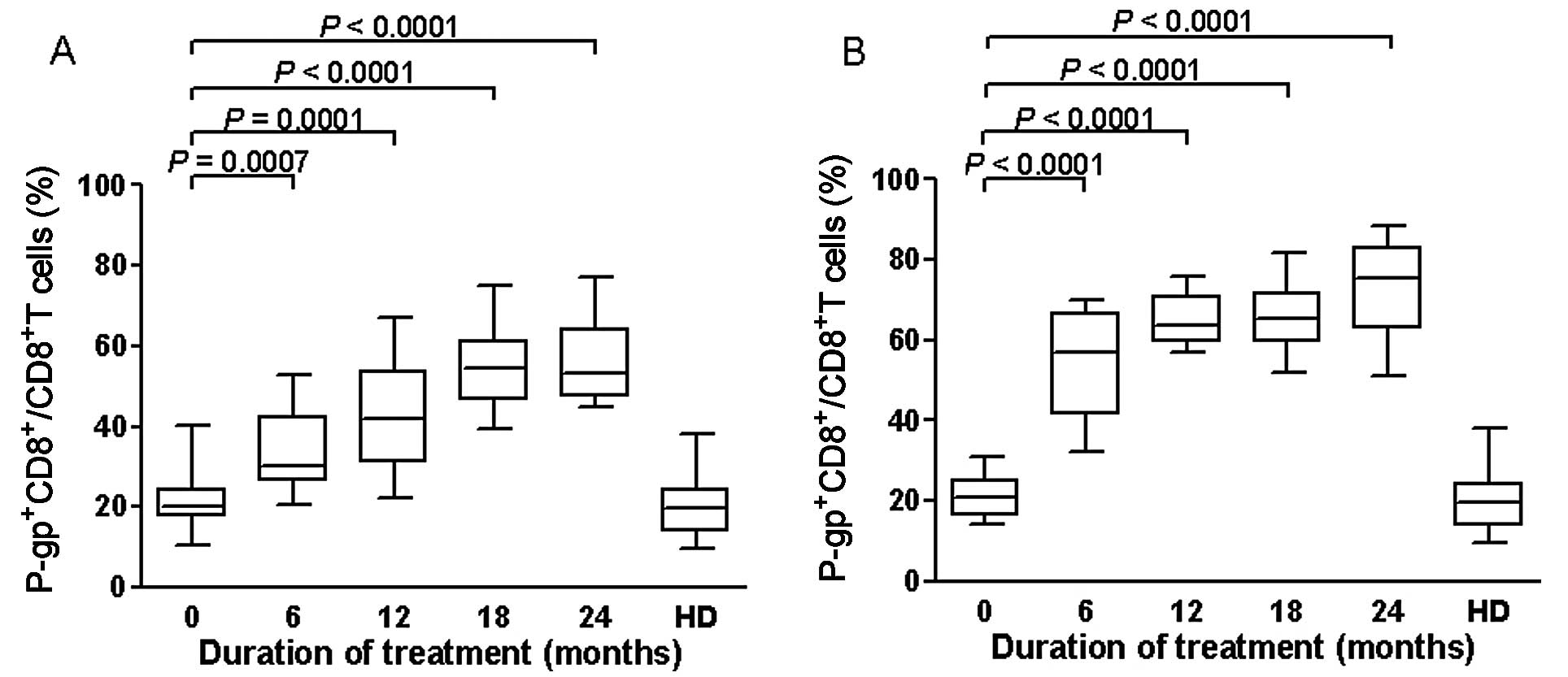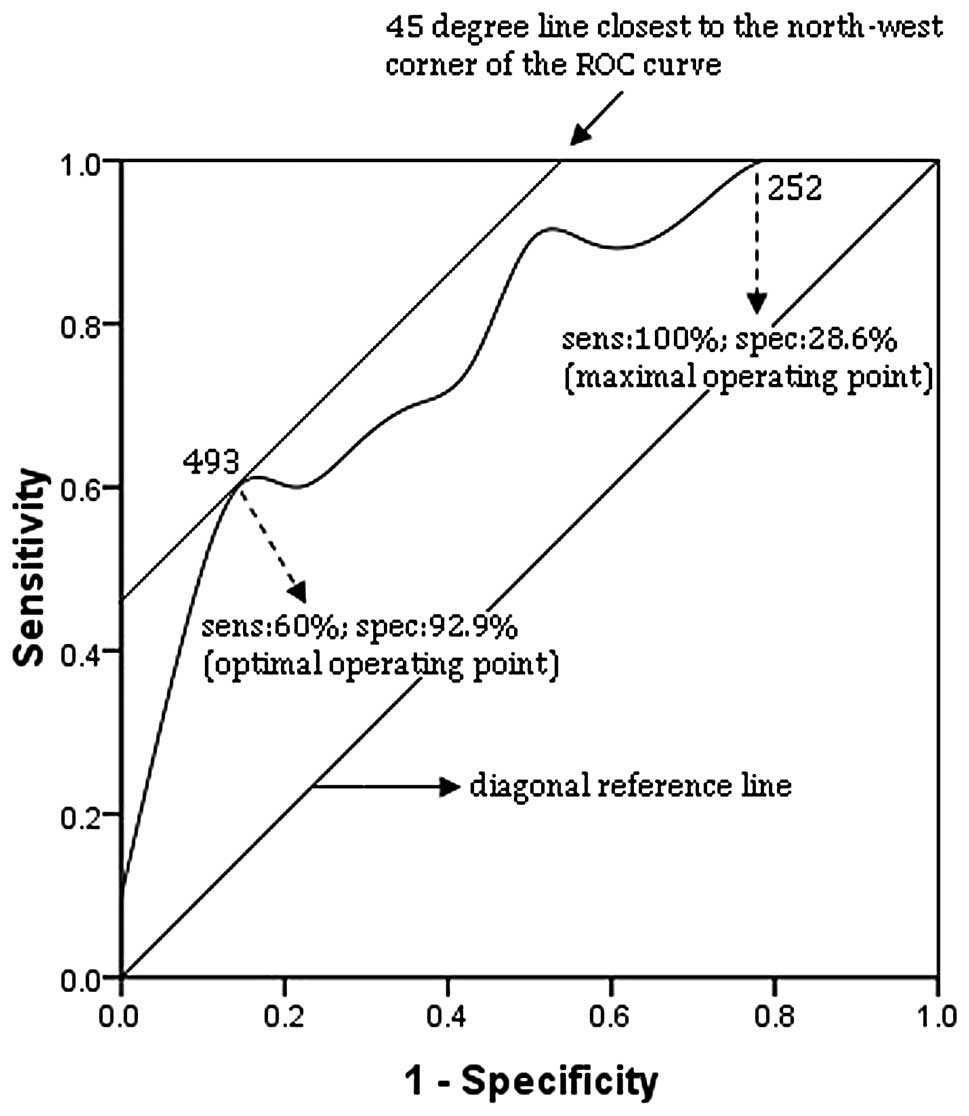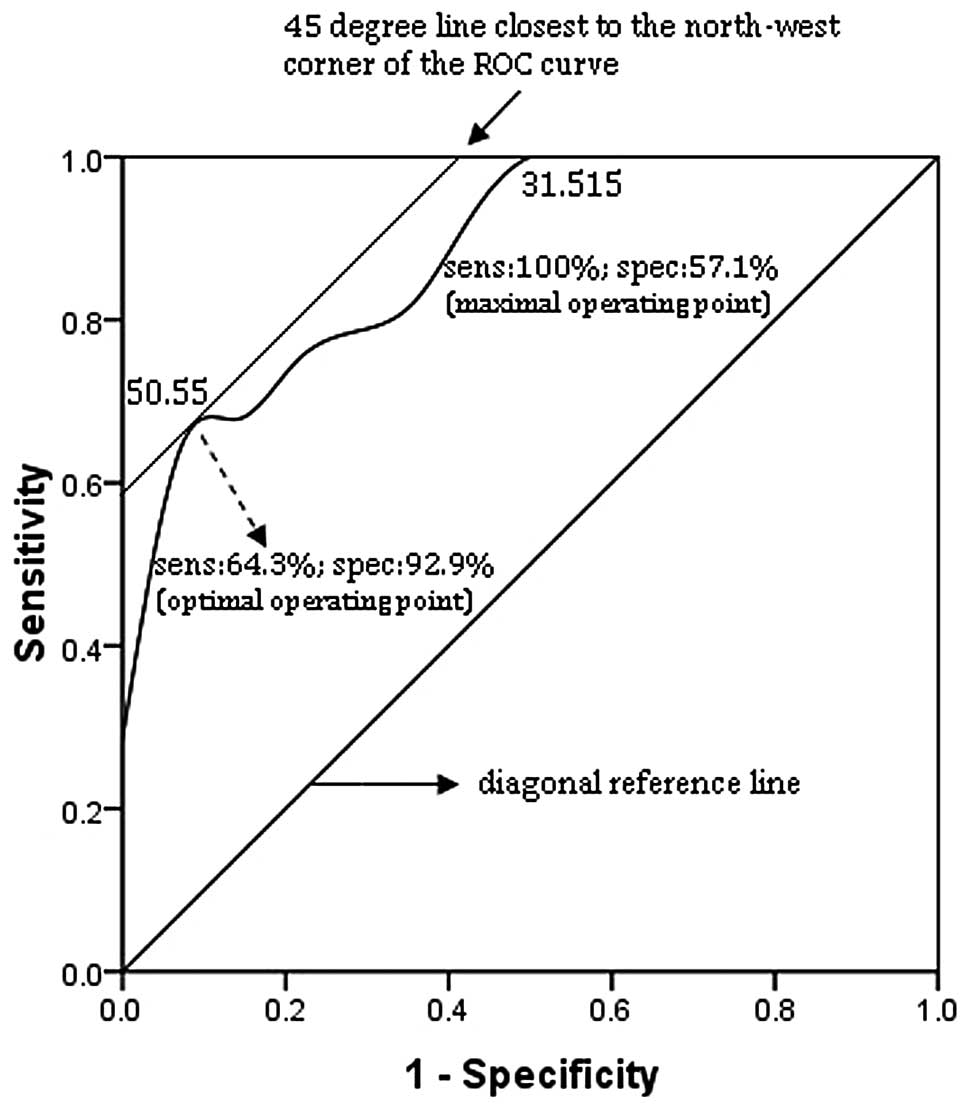Expression levels of P-glycoprotein in peripheral blood CD8+ T lymphocytes from HIV-1-infected patients on antiretroviral therapy
- Authors:
- Published online on: December 11, 2013 https://doi.org/10.3892/ijmm.2013.1584
- Pages: 431-440
Abstract
Introduction
P-glycoprotein (P-gp), the product of the multidrug resistance protein 1 (MDR1) (or ABCB1) gene in humans, is one of the most important and interesting members of the numerous, highly conserved, widespread membrane transporters of the ATP-binding cassette superfamily (1,2). P-gp has been found to be constitutively expressed in epithelial cells of tissues with excretory function, such as the intestine, liver, kidneys, lungs, the blood-brain barrier and placenta, as well as in blood cells such as lymphocytes, where P-gp expression may limit tissue penetration of its substrates (3). The role of P-gp expression and function in cells of the immune system in the treatment of HIV-1 infection has become a focus of research in recent years. P-gp-expressing cells, such as CD4+ lymphocytes, the primary target of HIV-1 infection, show limited intracellular accumulation of antiretroviral drugs (4,5). Therefore, the affinity of antiretroviral drugs to P-gp and the of expression level of P-gp and other transporters in lymphocyte subpopulations may be contributing factors in the response to antiretroviral therapy (ART).
Although preliminary results have shown that P-gp is expressed in peripheral blood CD4+ cells, there has been controversy whether antiretroviral drugs inhibit P-gp, while studies on P-gp expression in peripheral blood CD8+ cells of HIV-1-infected patients receiving antiretroviral regimens are limited. It is possible that the in vivo interaction of ART drugs with P-gp may reduce the intracellular drug concentrations, resulting in the insufficient suppression of HIV-1 replication, providing additional diagnostic evidence for the virologic response to ART during HIV-1 infection (6,7). Therefore, this study was carried out to measure the expression of P-gp in peripheral CD8+ T lymphocytes in HIV-1-infected patients, to investigate how the levels of P-gp are affected by ART in HIV-1 infection, and to assess the value of using P-gp expression to predict the virologic response to ART in a cohort of HIV-1-infected patients in China.
Materials and methods
Study subjects
Ninety-two HIV-1-infected patients on ART [58 patients treated with zidovudine (AZT) + lamivudine (3TC) + efavirenz (EFV) and 34 patients treated with AZT + 3TC + nevirapine (NVP)] and 49 HIV-1-infected ART-naïve patients who were consecutively treated at Lanzhou General Hospital (Lanzhou, China) and Tangdu General Hospital (Xi’an, China) participated in this study to compare the effects of ART on the levels of P-gp+CD8+ and CD4+ T cells. The patients were monitored with blood tests at each clinical visit, scheduled at baseline and every 3 months after the initiation of therapy.
We selected another 48 HIV-1-positive patients for which virologic and immunological data were available from baseline to 24 months after therapy, in order to assess the value of P-gp in predicting virologic response to ART. This group (26 patients treated with AZT + 3TC + EFV and 22 patients treated with AZT + 3TC + NVP), hereafter termed as the extreme group, was divided into 2 subgroups: good virologic responders were defined as patients who maintained a viral load below the detection limit of the assay (<40 copies/ml) at 6 months of therapy and at 12 months of follow-up. Poor virologic responders were defined as patients who had detectable viral loads (>40 copies/ml) at 6 and 12 months. For the patients in each group, we analyzed changes in CD4+ T cell count and viral load every 3 months during the follow-up and until 24 months.
As the control group for assessing the normal levels of measured cells, we included 24 healthy blood donors who were recruited at the same hospital. The local ethics committee approved the study, and all participants, after having been fully informed of the study procedures, provided written informed consent prior to enrollment.
Measurement of blood CD4+ T cell counts
The T lymphocyte subsets of all patients were measured by a 4-colour FACSCalibur cytometer (BD Biosciences, San Jose, CA, USA). The absolute CD4+ T cell number was calculated from the product of white cell counts. All measurements were made using the same flow cytometer and sample preparation over the duration of the study.
Virologic assessment
Batch viral load measurements were performed at the end of the study period on plasma samples which were stored at −80°C. The COBAS® TaqMan 48 Analyzer (Roche Diagnostics, Basel, Switzerland) was used for the detection and quantification of HIV RNA in the plasma, following the manufacturer’s instructions. RNA was extracted from 500 μl of plasma, following a generic nucleic acid isolation protocol, based on the adsorption of RNA molecules on a glass fiber and elution with an aqueous solution. We calculated the HIV-1 RNA titer in the tested samples based on the HIV-1 signal, the signal of the HIV-1 quantification standard and the lot-specific calibration constants provided with the COBAS TaqMan HIV-1 test. Reported values for the upper limit of quantification (ULQ) and the lower limit of quantification (LLQ) were 10,000,000 (7xlog10) and 40 (1.6xlog10) copies/ml, respectively.
Isolation of peripheral blood mononuclear cells (PBMCs)
PBMCs were isolated from venous blood samples and separated with centrifugation on a Ficoll-Hypaque (Sigma-Aldrich, St. Louis, MO, USA) density gradient. Following isolation, the PBMCs were immediately cryopreserved in RPMI-1640 medium supplemented with 10% FBS (both from Gibco-Invitrogen, Carlsbad, CA, USA) and 10% dimethyl sulfoxide (Merck, Amsterdam, The Netherlands) and stored in a liquid nitrogen tank. The frozen PBMCs were thawed with a step-by-step, gradual dilution method, as previously described (8). Cell viability was >90%, as assessed by a trypan blue exclusion assay.
Quantification of MDR1 mRNA expression by quantitative reverse transcription PCR (qRT-PCR)
Total RNA from 3×106 PBMCs was extracted and purified using an RNeasy Mini Kit (Qiagen, Hilden, Germany) according to the instructions provided by the manufacturer. For first-strand cDNA synthesis, 0.5 μg of total RNA and 1 μl of oligo(dT)18 primer were incubated with 2 μg of a 10-nM dNTP mix, 20 U RNase inhibitor, 4 μg of 5X reaction buffer and 200 U M-MuLV reverse transcriptase (RT) (Revert Aid First Strand cDNA Synthesis kit; Fermentas, Hanover, MD, USA), in a total volume of 20 μl, for 1 h at 42°C. Negative controls were obtained by replacing the enzyme with water.
Quantitative PCR was performed on a LightCycler® instrument (Roche Diagnostics, Meylan, France) using the SYBR Premix Ex Taq II detection kit (Takara Bio Inc., Otsu, Japan). PCR was performed in a 20 μl of solution, consisting of 2.0 μl of the cDNA sample, 10.0 μl of 2X SYBR Premix Ex Taq II buffer (containing Taq DNA polymerase, reaction buffer and deoxynucleotide triphosphate mixture), 6.4 μl of nuclease-free water and 0.8 μl of each primer (10 μM). The primers for the amplification of MDR1 were described previously (9), and their sequences are shown in Table I. Cycling parameters were as follows: 30 sec at 95°C, followed by 40 cycles of 5 sec at 95°C, 20 sec at 60°C and 0 sec at 95°C, followed by 15 sec at 65°C and 0 sec at 95°C. Relative mRNA quantities were calculated using the 2−ΔΔCt method (10), using the housekeeping gene coding for the TATAA-box binding protein (TBP) for normalization, and are represented as fold changes relative to the samples with the lowest mRNA expression. To compare the mRNA expression level of MDR1 between the subjects or subject groups, the ratio of the MDR1 transcript level to the TBP transcript level was calculated. The mean value (duplicate measurements) was shown in each case. The PCR products were subjected to gel electrophoresis to ensure the size of the specific amplicons of interest and to confirm the absence of non-specific PCR products. To further confirm their sequences, the resultant PCR products were further sequenced. The specificity of each reaction was also assessed by carrying out melting curve analysis, to ensure that only one product was present. All samples were amplified in triplicate.
Detection of P-gp by ELISA
The CD8+ T cells were purified by a negative selection method, using magnetic-activated cell sorting (MACS; Miltenyi Biotec GmbH, Bergisch Gladbach, Germany) according to the manufacturer’s instructions. The relative levels of P-gp in the CD8+ T cells were quantified using ELISA kits (Cusabio Biotech, Wuhan, China) according to the manufacturer’s instructions. Each assay was carried out in triplicate wells.
Quantification of P-gp expression by flow cytometry
To quantify P-gp protein expression, flow cytometry analysis was performed on the stored PBMC samples using fluorochrome-conjugated antibodies specific for the surface markers, CD3, CD4, CD8 and P-gp. Approximately 1×106 PBMCs, diluted in 2 ml phosphate-buffered saline (PBS) containing 1% FBS were transferred to 5-ml sterile tubes. The cells were harvested following centrifugation at 1,500 rpm for 10 min at 4°C. The following antibodies were used for staining: anti-CD3-PerCP, anti-CD4-FITC, anti-CD8-APC (all from BD Biosciences) and mouse anti-human ABCB1 PE-conjugated monoclonal antibody (eBioscience, San Diego, CA, USA). The cells were incubated and stained at 4°C in the dark for 30 min, and were then analyzed with a 4-colour FACSCalibur cytometer. Image acquisition was performed using CellQuest software (BD Biosciences), and data analyses were performed using FlowJo software version 8.6 (Tree Star Inc., Ashland, OR, USA). Isotype control antibodies were used to separate the infected from the control cells in the FITC, PerCP, PE and APC fluorescence channels.
Rhodamine 123 (Rh123) efflux assay
P-gp activity was determined by estimating the efflux of Rh123 (Sigma-Aldrich), a fluorescent dye that is a P-gp substrate, as previously described (11). Briefly, 200 μl of purified cell suspension was incubated with Rh123 (final concentration, 200 ng/ml) for 20 min under 5% CO2 at 37°C. After washing, the cells were incubated in Rh123-free medium in the presence or absence of cyclosporine A (CsA; Sigma-Aldrich), a P-gp-specific competitive inhibitor (final concentration, 1, 000 ng/ml), for 30 min under 5% CO2 at 37°C. Finally, the cells were washed in CsA-containing RPMI-1640 medium and stained with phycoerythrin (PE)-conjugated, anti-CD3 and anti-CD8 antibodies (both from BD Biosciences). After staining, the cells were washed twice, resuspended in PBS and kept at 4°C in the dark for 20 min.
The data were analyzed with a FACSCalibur flow cytometer using CellQuest software. The efflux of Rh123 from the PBMCs was assessed by analyzing the changes in cellular fluorescence in the presence or absence of CsA. The Rh123 fluorescence emits at a wavelength of 488 nm and was detected on fluorescence channel (FL)1 of the flow cytometer. PE fluorescence was detected on FL2. The forward- and side-scatter were used to gate the cell population of lymphocytes. For each sample, 10,000 events were collected. The data were analyzed using the Kolmogorov-Smirnov (KS) statistic, which measures the difference between 2 distribution functions and generates a D-value, ranging from 0 to 1.0. A higher D-value indicates a higher difference between the distribution functions, and thus, a strong expression of P-gp.
Statistical analysis
Data were summarized by computing the median and interquartile range (IQR). Undetectable viral loads were assigned a value of 20 RNA copies/ml (average of maximum and minimum undetectable values). Differences between independent groups were tested for statistical significance using the Mann-Whitney U test or the Wilcoxon signed-rank test for paired data (time-paired data in each group).
For each virologic and immunological parameter, sensitivities, specificities, positive and negative predictive values were assessed as to their ability to define the response to treatment in the entire cohort (e.g., the sensitivity of high levels of activated cells in identifying patients with a detectable viral load during the follow-up months). The performance of these evaluations was studied by receiver operating characteristic (ROC) curves. ROC curves depict the true positive rate (sensitivity) vs. the false positive rate [1 minus the specificity (1-specificity) or true negative rate]. The area under the curve (AUC) was used to measure discrimination, i.e., the ability of the test to correctly classify good and poor responders. An AUC of 1 represents a perfect test [sensitivity = 1 (100%), specificity = 1 (100%)]. Cut-off values with the highest discrimination capacity between good and poor responders were established. Confidence intervals (CI) of 95% were used to depict uncertainty in the estimates of sensitivity and specificity. All statistical analyses were performed using SPSS 16.0 software for Windows (SPSS Inc., Chicago, IL, USA). The Spearman correlation coefficient was calculated to assess the association between the proportion of P-gp-expressing CD8+ T cells and other virologic or immunological parameters. Coefficients of variation (%) were expressed as (SD/mean) ×100. A value of P<0.05 was considered to indicate a statistically significant difference.
Results
Patient characteristics
A total of 92 patients were enrolled in the initial analysis, with more than half (79.7%) being male (Table II). The median age of the HIV-1-infected patients on ART was 35 years (IQR, 22–55), the median age of the HIV-1-infected ART-naïve patients was 33 years (IQR, 19–46), and there were no significant differences in age among the different groups. The median CD4+ T cell count of the HIV-1-infected patients on ART was 217 cells/μl (IQR, 3–615), and the median HIV RNA level was 2.2 log10 copies/ml (IQR, 1.6–4.2). The median CD4+ T cell count of the HIV-1-infected ART-naïve patients was 103 cells/μl (IQR, 6–231), and the median HIV RNA level was 3.8 log10 copies/ml (IQR, 2.6–5.5).
Of the 48 patients that had received ART for 2 years, 20 were categorized as good virologic responders and 28 as poor virologic responders. The median ages were 40 years (IQR, 33–43) for the good responders, 42 years (IQR, 34–41) for the poor responders, and 28 years (IQR, 25–33) for the healthy blood donors. Median CD4+ T cell counts at baseline were estimated at 269.5 cells/μl (IQR, 210.3–339.8) for the good responders, 321 cells/μl (IQR, 228.3–341.3) for the poor responders (P>0.05), and 721 cells/μl (IQR, 620–839) for the healthy blood donors (P<0.05). Plasma RNA viral load at baseline was similar for good and poor responders [4.5 log10 copies/ml (IQR, 4.2–4.8) and 4.6 log10 copies/ml (IQR, 4.5–4.9), respectively, P>0.05] (Table III). The viral load of the good responders was maintained below the detection limit for at least 12 months. By contrast, in the poor responders, median viral loads were 3.0 log10 and 3.9 log10 copies/ml after 6 and 12 months of therapy, respectively.
Table IIIDemographic and immunological parameters of the 48 HIV-1-infected patients, defined as the extreme group. |
Expression of MDR1 transcripts
The relative mRNA levels for the MDR1 gene in the HIV-1-infected patients on ART, the HIV-1-infected ART-naïve patients and the healthy donors are shown in Fig. 1A. The MDR1 gene was detected in all the groups analyzed. The mRNA levels of MDR1 were low in both the HIV-1-infected ART-naïve patients and the healthy blood donors, and were significantly lower than those observed in the HIV-1-infected patients on ART. As regards the demographic and immunological characteristics of the patients, MDR1 expression did not correlate with age, gender, or the initial white blood cell count.
Expression of P-gp in CD8+ T cells of HIV-1-infected patients
P-gp expression in the CD8+ T cells was detected by ELISA in the 92 HIV-1-infected patients on ART, the 49 HIV-1-infected ART-naïve patients and the 24 healthy blood donors (Fig. 1B). The levels of P-gp in the HIV-1-infected patients on ART were significantly higher than those observed in the HIV-1-infected ART-naïve patients and the healthy blood donors.
The expression of P-gp was further quantified by flow cytometry in the same groups. As shown in Fig. 2, a high inter-individual variability was observed in the samples from the 3 groups, with coefficients of variation (CV) approaching 40%. Notably, the highest degree of variability was observed for the HIV-1-infected patients on ART (45.55%).
Despite the high variability in all 3 groups, the expression level of P-gp was significantly higher in the HIV-1-infected patients on ART compared with the HIV-1-infected ART-naïve patients (P<0.0001) and the healthy blood donors (P<0.0001). Specifically, the mean (± SD) values of the expression of P-gp were as follows: 31.93±14.55 (IQR, 11.79–79.50) in the HIV-1-infected patients on ART, 22.40±8.101 (IQR, 8.03–39.73) in the HIV-1-infected ART-naïve patients, and 19.57±7.124 (IQR, 9.42–38.12) in the healthy donors.
Comparison of P-gp activity in the CD8+ T cells between the HIV-1-infected patients and healthy donors
In order to evaluate the ability of P-gp to actively pump drugs from the cytosol and plasma membrane into the extracellular space, we analyzed the amounts of extruded Rh123 via calculations of the D-value in CD8+ cells. We then compared the P-gp activity in peripheral CD8+ cells between healthy donors and HIV-1-infected patients. P-gp activity tended to be higher in the HIV-1-infected patients on ART, and statistically significant differences were noted in P-gp activity (Fig. 3) between the HIV-1-infected patients on ART and the HIV-1-infected ART-naïve patients, as well as between the HIV-1-infected patients on ART and the healthy donors (P<0.001 and P<0.001, respectively).
Correlation of P-gp+CD8+ T cell with blood CD4+ T cell count
To investigate whether the increase in P-gp expression in peripheral blood CD8+ T lymphocytes correlates with the blood CD4+ T cell count, we measured the CD4+ T cells in the recruited patients. Due to the limited availability of the material, it was not possible to evaluate the CD4+ T cell numbers for all the HIV-1-infected patients; the number of CD4+ T cells was measured in 39 HIV-1-infected patients on ART. We found a significant inverse correlation between P-gp+CD8+ T cell and CD4+ T cell counts in the HIV-1-infected patients on ART (Fig. 4). The correlation between these 2 cell populations was also investigated in the HIV-1-infected ART-naïve group and the healthy donors group, but no significant correlation was found (P>0.05, data not shown).
Correlation between expression of P-gp and virologic parameters
Spearman’s correlation analysis was used to determine whether the expression levels of P-gp are associated with the level of plasma HIV RNA. The results revealed no evidence of the prognostic value of P-gp expression in HIV-1 infection, since no correlation was observed between P-gp expression and the level of plasma HIV-RNA in HIV-1-infected patients on ART (P>0.05, data not shown).
Changes in numbers of P-gp+CD8+ T cells among good and poor virologic responders
In the good-responder group, 6 the median levels of CD4+ T cells increased steadily from 269.5 cells/μl at baseline to 486.5 cells/μl at 24 months (P<0.0001) (Figs. 5A and 6A). At baseline, the median percentage of P-gp+CD8+ T cells relative to the entire population of CD8+ lymphocytes increased from 20% (IQR, 17.45–24.30%) to 30.31% (IQR, 26.29–42.32%) after 6 months of therapy (P=0.0007), and finally, to 53.31% (IQR, 47.50–64.25%) after 24 months of therapy (P<0.0001) (Fig. 7A). The expression levels of P-gp+CD8+ T cells at baseline were comparable to those observed in the healthy blood donors (P=0.45).
In the poor-responder group, CD4+ T cell levels at baseline were 321 cells/l (IQR, 228.3–341.3), and increased to 462.5 cells/μl at 24 months of ART (P=0.012) (Figs. 5B and 6B). The relative percentage of P-gp+CD8+ T cells relative to the entire population of CD8+ lymphocytes reached 56.98% (IQR, 41.25–66.65%) at 6 months of therapy (P=0.0001 compared to the beginning of ART), and 75.37% (IQR: 62.87–83.17%) at 24 months of ART (P<0.0001) (Fig. 7B). The median percentage of P-gp+CD8+ T cells was comparable to that of the healthy blood donors (P=0.33) at baseline.
Predictive value of immunological markers for the response to treatment
We examined whether the absolute CD4+ T cell count or the relative proportion of P-gp+CD8+ cells can be used for discriminating the response to treatment between the good- and poor-responder groups. For each parameter, we plotted the true positive rate (sensitivity) and the false positive rate (1-specificity) in a ROC curve for various cut-off values (see Fig. 8 for CD4+ T cell count at 6 months and Fig. 9 for P-gp+CD8+ cell percentages at 6 months). The AUC was used to assess and compare the discriminatory power of the 2 markers in the good- and poor-responder groups (Table IV). The AUC of an ideal test equals 1, whereas the AUC of a poor test equals 0.5. In the present study, the P-gp+CD8+ cell percentage was the best predictor of virologic response with an associated AUC value equal to 0.885, 0.946, 0.814 and 0.852 at 6, 12, 18 and 24 months, respectively. Absolute CD4 counts did not show any discriminatory value for the response to treatment, with associated AUC values close to 0.5 and P>0.5 for all months, apart from the 6th month (Table IV and Fig. 8). The use of P-gp mean fluorescence intensity (MFI) as a marker did not improve the sensitivity and specificity of the discriminatory assay compared to the P-gp+CD8+ T cell percentage (data not shown).
Table IVAUC, P-values and 95% CI corresponding to each parameter analyzed on the ROC curve for its discriminating value between good and poor responders within the HIV-1-infected group (extreme group; n=48). |
A range of cut-off values between the optimal operating point (i.e., the cut-off value yielding the best trade-off between sensitivity and specificity) and the maximal sensitivity point (highest possible sensitivity value) was identified from the ROC curve of P-gp+CD8+ percentages at 6 months of ART. The results are presented in Table V.
Table VSensitivity and specificity of P-gp+CD8+ cell percentages associated with different cut-off values in predicting good and poor virologic response to antiretroviral therapy (ART) in the HIV-1-infected group (exteme group; n=48). |
Discussion
Drug interactions between anti-HIV drugs, as well as viral resistance to ART drugs, represent a considerable limitation to the safety and effectiveness of ART. As regards HIV-1 infection, several studies have reported that a number of ATP-dependent transport proteins, such as P-gp, breast cancer resistance protein (BCRP), multidrug resistance-associated protein (MRP)1, MRP4 and MRP5, are able to transport antiretroviral drugs (12–15). Although evidence for the central role of other transporters in the pharmacokinetics of the interaction with antiretroviral drugs is accumulating, the role of P-gp is far from being elucidated, particularly in large clinical cohorts of patients with HIV-1 infection.
HIV-1 infections are treated with HIV-protease inhibitors (PIs), nucleosides (NRTIs), non-nucleosides (NNRTIs) and nucleotide reverse transcriptase (NtRTIs) inhibitors. The combined administration of different drugs in ART improves the disease outcome, while increasing the likelihood of drug interactions. P-gp represents an important site for drug interactions and the induction of its activity can reduce the effectiveness of drugs that are P-gp substrates. PIs are well established inducers of P-gp (16–19), while data on P-gp modulation by NRTIs and NNRTIs are limited and often conflicting, mainly due to the difficulties in comparing induction results from different assays.
The induction of P-gp expression by AZT in tumor cell lines was found by Gollapudi and Gupta (20). Their study demonstrated that HIV-1-infected T cells, as well as monocytic cell lines, have increased levels of P-gp, while AZT accumulates in significantly lower quantities in these cells compared to uninfected cells (20). Likewise, a decrease in AZT accumulation in P-gp-overexpressing CEM VBL100 cells with a corresponding decline in sthe antiviral efficacy of the drug was observed in another study (21).
Weiss et al (22) demonstrated the induction, with different potencies, of P-gp activity by a number of NRTIs and NNRTIs, such as EFV and NVP. In the Caco-2 cell line, the NNRTIs NVP, EFV and delavirdine, which are not P-gp substrates, were shown to induce the expression and activity of P-gp, with NVP being the most potent inducer compared with the other 2 NNRTIs (23). Another study also reported the P-gp-inducing properties of delavirdine, EFV and NVP (24); however, results from studies aiming to assess whether these NNRTIs are also substrates and/or inhibitors of P-gp are conflicting (25,26). Moreover, the few studies available used different methods, resulting in restricted comparability and ambiguous conclusions. In our study, the recruited patients who were receiving the AZT + 3TC + EFV/NVP treatment showed higher levels of of P-gp in their CD8+ T cells compared with ART-naïve patients, which suggests that NRTIs/NNRTIs may have P-gp-inducing properties and may contribute to drug resistance to ART in HIV-1 infection.
The data from the present study indicate that there is a high inter-individual variability in the protein expression of P-gp in both HIV-1-infected patients (on ART or ART-naïve) and healthy blood donors. The degree of variability in CD8+ T lymphocytes was higher in the patients on ART compared with the ART-naïve patients and healthy donors, which suggests that the therapy may contribute to the variability of the expression of this transporter. However, the coefficient of variation of the measured P-gp expression in the CD8+ cells of the HIV-1-infected patients on ART was 29%, which is less than coefficients 61, 40 and 37% reported in previous studies (27–29); these discrepancies are possibly due to different methods used to quantify the expression or to the different study subjects. Although variations in P-gp levels in the CD4+ population in our study were also reduced compared to previous studies (data not shown), the tendency for CD4+ cells to express lower levels of P-gp compared to CD8+ cells is in agreement with previous studies (30,31). Overall, the variability in expression of P-gp in the lymphocyte subpopulations reported in our study is similar or reduced compared to other studies. ART appears to affect the expression of P-gp, since its expression was significantly higher in HIV-1-infected patients on ART compared with HIV-1-infected ART-naïve patients and healthy donors. This result is in agreement with previous in vitro studies demonstrating that the expression of ABC transporters in PBMCs is increased in HIV-1 infection due to ART (32–34).
There was a significant inverse correlation between P-gp+CD8+ T cell counts and CD4+ cell counts in HIV-1-infected patients on ART in our study. A previous study (35) demonstrated that the basal expression of P-gp in different cell populations ranks as follows: CD56+ >CD8+ >CD4+. However, the ratio of CD4+/CD8+ cells is reversed as CD4+ T cells are continuously destroyed by the invading virus in HIV-1 infections, and therefore, the expression of P-gp may vary at different stages of the infection.
In our study, P-gp expression did not correlate with viral load, although the transporter expression in HIV-1-infected patients on ART was higher compared with HIV-1-infected ART-naïve patients and healthy donors, which supports the hypothesis that several factors may be involved in HIV infection. The role of antiretroviral drugs in modulating the expression of ABC transporters has not yet been elucidated. The possibility that both therapy and HIV-1 infection may modulate the transporter expression and translation cannot be ruled out. Moreover, increasing evidence suggests that P-gp directly inhibits the replication of enveloped viruses, and that P-gp expression may inhibit HIV-mediated membrane fusion, as well as subsequent steps in the HIV-1 life cycle (36–38). Overall, we cannot ascertain that the lower viral loads observed in the good virologic responders are related to ART-enhanced P-gp expression.
We also analyzed the changes in the levels of CD4+ T cells, the plasma viral load and the percentages of P-gp+CD8+ T cells throughout 24 months of ART. The suppression of HIV-1 replication following ART induced significant changes in P-gp expression in the majority of patients. Our study provided evidence for a progressive increase in the percentage of P-gp+CD8+ T cells, with steadily increasing CD4+ T cell counts and a sharp delcine in the plasma viral load, indicating that P-gp+CD8+ T cells may represent a marker monitoring the response to ART when the viral load decreases to levels lower than the detection limit after antiretroviral intervention.
We used ROC curves to assess the sensitivity and specificity of the percentage of P-gp+CD8+ and CD4+ T cells to predict virologic response. We found that the relative proportion of P-gp+CD8+ T cells is a more efficient predictive marker compared to CD4+ T cell counts. This result confirmed previous findings that the percentage of P-gp+CD8+ T cells constitutes a good marker of virologic response in HIV-1-infected patients on ART.
There are certain limitations to the current study, in particular, the small sample size and the fact that data on the effects of viral suppression on CD8+ T cell counts in patients who did not respond to ART was lacking. Future studies including a group of patients who do not respond to ART are required to provide crucial information on the effects of ART on P-gp expression in HIV-1 infection. Furthermore, additional time-series data on the expression of the transporter in patients and healthy volunteers are required to define the exact effect of drug-to-drug interactions on the expression of P-gp.
In conclusion, the results from the present study suggest that P-gp expression varies among HIV-1-infected patients, but is significantly increased upon ART in HIV-1-infected patients. The overexpression of P-gp is affected during the initiation of ART in HIV-1 infection and the P-gp+CD8+ T cell count may provide an additional criterion for estimating the response to ART. The relative proportion of P-gp+CD8+ T cells appeared to provide a sensitive estimate of the virologic response to ART in comparison to the blood CD4+ T cell count. P-gp expression and its correlation to the virologic and immunological parameters of HIV-infected patients warrants further investigation using a larger study group to determine the effects of P-gp expression on clinical outcome.
Acknowledgements
The authors would like to thank all the subjects who generously participated in this study. This study was supported by a grant from the Social Development Scientific Project of Natural Science Foundation of Shaanxi Province (No. 2012SF2-01-5).
References
|
Aller SG, Yu J, Ward A, et al: Structure of P-glycoprotein reveals a molecular basis for poly-specific drug binding. Science. 323:1718–1722. 2009. View Article : Google Scholar : PubMed/NCBI | |
|
Namanja HA, Emmert D, Davis DA, et al: Toward eradicating HIV reservoirs in the brain: inhibiting P-glycoprotein at the blood-brain barrier with prodrug abacavir dimers. Am Chem Soc. 134:2976–2980. 2012. View Article : Google Scholar : PubMed/NCBI | |
|
Thiebaut F, Tsuruo T, Hamada H, et al: Cellular localization of the multidrug-resistance gene product P-glycoprotein in normal human tissues. Proc Natl Acad Sci USA. 84:7735–7738. 1987. View Article : Google Scholar : PubMed/NCBI | |
|
Choudhuri S and Klaassen CD: Structure, function, expression, genomic organization, and single nucleotide polymorphisms of human ABCB1 (MDR1), ABCC (MRP), and ABCG2 (BCRP) efflux transporters. Int J Toxicol. 25:231–259. 2006. View Article : Google Scholar | |
|
Moon YJ, Zhang S and Morris ME: Real-time quantitative polymerase chain reaction for BCRP, MDR1, and MRP1 mRNA levels in lymphocytes and monocytes. Acta Haematol. 118:169–175. 2007. View Article : Google Scholar : PubMed/NCBI | |
|
Kock K, Grube M, Jedlitschky G, et al: Expression of adenosine triphosphate-binding cassette (ABC) drug transporters in peripheral blood cells: relevance for physiology and pharmacotherapy. Clin Pharmacokinet. 46:449–470. 2007. View Article : Google Scholar : PubMed/NCBI | |
|
Varatharajan L and Thomas SA: The transport of anti-HIV drugs across blood-CNS interfaces: summary of current knowledge and recommendations for further research. Antiviral Res. 82:A99–A109. 2009. View Article : Google Scholar : PubMed/NCBI | |
|
Rehermann B and Naoumov NV: Immunological techniques in viral hepatitis. J Hepatol. 46:508–520. 2007. View Article : Google Scholar : PubMed/NCBI | |
|
Giraud C, Declèves X, Perrot JY, et al: High levels of P-glycoprotein activity in human lymphocytes in the first 6 months of life. Clin Pharmacol Ther. 85:289–295. 2009. View Article : Google Scholar : PubMed/NCBI | |
|
Livak KJ and Schmittgen TD: Analysis of relative gene expression data using real-time quantitative PCR and the 2(-Delta Delta C(T)) method. Methods. 25:402–440. 2001. View Article : Google Scholar : PubMed/NCBI | |
|
Chaudhary PM, Mechetner EB and Roninson IB: Expression and activity of the multidrug resistance P-glycoprotein in human peripheral blood lymphocytes. Blood. 80:2735–2739. 1992.PubMed/NCBI | |
|
Lee CG and Gottesman MM: HIV-1 protease inhibitors and the MDR1 multidrug transporter. J Clin Invest. 101:287–288. 1998. View Article : Google Scholar : PubMed/NCBI | |
|
Srinivas RV, Middlemas D, Flynn P and Fridland A: Human immunodeficiency virus protease inhibitors serve as substrates for multidrug transporter proteins MDR1 and MRP1 but retain antiviral efficacy in cell lines expressing these transporters. Antimicrob Agents Chemother. 42:3157–3162. 1998. | |
|
Huisman MT, Smit JW and Schinkel AH: Significance of P-glycoprotein for the pharmacology and clinical use of HIV protease inhibitors. AIDS. 14:237–242. 2000. View Article : Google Scholar : PubMed/NCBI | |
|
Janneh O, Owen A, Chandler B, et al: Modulation of the intracellular accumulation of saquinavir in peripheral blood mononuclear cells by inhibitors of MRP1, MRP2, Pgp and BCRP. AIDS. 19:2097–2102. 2005. View Article : Google Scholar : PubMed/NCBI | |
|
Perloff MD, von Moltke LL, Marchand JE and Greenblatt DJ: Ritonavir induces P-glycoprotein expression, multidrug resistance-associated protein (MRP1) expression, and drug transporter-mediated activity in a human intestinal cell line. J Pharm Sci. 90:1829–1837. 2001. View Article : Google Scholar | |
|
Perloff ES, Duan SX, Skolnik PR, et al: Atazanavir: effects on P-Glycoprotein transport and CYP3A metabolism in vitro. Drug Metab Dispos. 33:764–770. 2005. View Article : Google Scholar : PubMed/NCBI | |
|
Huang L, Wring SA, Wooley JL, et al: Induction of P-glycoprotein and cytochrome P450 3A by HIV protease inhibitors. Drug Metab Dispos. 29:754–760. 2001.PubMed/NCBI | |
|
Mukwaya G, MacGregor T, Hoelscher D, et al: Interaction of ritonavir-boosted tipranavir with loperamide does not result in loperamideassociated neurologic side effects in healthy volunteers. Antimicrob Agents Chemother. 49:4903–4910. 2005. View Article : Google Scholar : PubMed/NCBI | |
|
Gollapudi S and Gupta S: Human immunodeficiency virus I-induced expression of P-glycoprotein. Biochem Biophys Res Commun. 171:1002–1007. 1990. View Article : Google Scholar : PubMed/NCBI | |
|
Antonelli G, Turriziani O, Cianfriglia M, et al: Resistance of HIV-1 to AZT might also involve the cellular expression of multidrug resistance P-glycoprotein. AIDS Res Hum Retroviruses. 8:1839–1844. 1992. View Article : Google Scholar : PubMed/NCBI | |
|
Weiss J, Rose J, Storch CH, et al: Modulation of human BCRP (ABCG2) activity by anti-HIV drugs. J Antimicrob Chemother. 59:238–245. 2007. View Article : Google Scholar : PubMed/NCBI | |
|
Stormer E, von Moltke LL, Perloff MD and Greenblatt DJ: Differential modulation of P-glycoprotein expression and activity by non-nucleoside HIV-1 reverse transcriptase inhibitors in cell culture. Pharm Res. 19:1038–1045. 2002. View Article : Google Scholar : PubMed/NCBI | |
|
Chandler B, Almond L, Ford J, et al: The effects of protease inhibitors and nonnucleoside reverse transcriptase inhibitors on P-glycoprotein expression in peripheral blood mononuclear cells in vitro. J Acquir Immune Defic Syndr. 33:551–556. 2003. View Article : Google Scholar | |
|
De Maat MMR, Ekhart GC, Huitema ADR, et al: Drug interactions between antiretroviral drugs and comedicated agents. Clin Pharmacokinet. 42:223–282. 2003.PubMed/NCBI | |
|
Sankatsing SU, Beijnen JH, Schinkel AH, et al: P-glycoprotein in human immunodeficiency virus type 1 infection and therapy. Antimicrob Agents Chemother. 48:1073–1081. 2004. View Article : Google Scholar : PubMed/NCBI | |
|
Andreana A, Aggarwal S, Gollapudi S, et al: Abnormal expression of a 170-kilodalton P-glycoprotein encoded by MDR1 gene, a metabolically active efflux pump, in CD4+ and CD8+ T cells from patients with human immunodeficiency virus type 1 infection. AIDS Res Hum Retroviruses. 12:1457–1462. 1996. View Article : Google Scholar : PubMed/NCBI | |
|
Lucia MB, Cauda R, Landay AL, et al: Transmembrane P-glycoprotein (P-gp/P-170) in HIV infection: analysis of lymphocyte surface expression and drug-unrelated function. AIDS Res Hum Retroviruses. 11:893–901. 1995. View Article : Google Scholar : PubMed/NCBI | |
|
Ford J, Hoggard PG, Owen A, et al: A simplified approach to determining P-glycoprotein expression in peripheral blood mononuclear cell subsets. J Immunol Methods. 274:129–137. 2003. View Article : Google Scholar : PubMed/NCBI | |
|
Chong AS, Markham PN, Gebel HM, et al: Diverse multidrug-resistance-modification agents inhibit cytolytic activity of natural killer cells. Cancer Immunol Immunother. 36:133–139. 1993. View Article : Google Scholar : PubMed/NCBI | |
|
Ludescher C, Pall G, Irschick EU and Gastl G: Differential activity of P-glycoprotein in normal blood lymphocyte subsets. Br J Haematol. 101:722–727. 1998. View Article : Google Scholar : PubMed/NCBI | |
|
Hayashi K, Pu H, Tian J, et al: HIV-Tat protein induces P-glycoprotein expression in brain microvascular endothelial cells. J Neurochem. 93:1231–1241. 2005. View Article : Google Scholar : PubMed/NCBI | |
|
Jorajuria S, Dereuddre-Bosquet N, Naissant-Storck K, et al: Differential expression levels of MRP1, MRP4, and MRP5 in response to human immunodeficiency virus infection in human macrophages. Antimicrob Agents Chemother. 48:1889–1891. 2004. View Article : Google Scholar : PubMed/NCBI | |
|
Turriziani O, Gianotti N, Falasca F, et al: Expression levels of MDR1, MRP1, MRP4, and MRP5 in peripheral blood mononuclear cells from HIV infected patients failing antiretroviral therapy. J Med Virol. 80:766–771. 2008. View Article : Google Scholar : PubMed/NCBI | |
|
Klimecki WT, Futscher BW, Grogan TM and Dalton WS: P-glycoprotein expression and function in circulating blood cells from normal volunteers. Blood. 83:2451–2458. 1994.PubMed/NCBI | |
|
Raviv Y, Puri A and Blumenthal R: P-glycoprotein-overexpressing multidrug-resistant cells are resistant to infection by enveloped viruses that enter via the plasma membrane. FASEB J. 14:511–515. 2000. | |
|
Lee CG, Ramachandra M, Jeang KT, et al: Effect of ABC transporters on HIV-1 infection: inhibition of virus production by the MDR1 transporter. FASEB J. 14:516–522. 2000.PubMed/NCBI | |
|
Speck RR, Yu XF, Hildreth J and Flexner C: Differential effects of p-glycoprotein and multidrug resistance protein-1 on productive human immunodeficiency virus infection. J Infect Dis. 186:332–340. 2002. View Article : Google Scholar : PubMed/NCBI |



